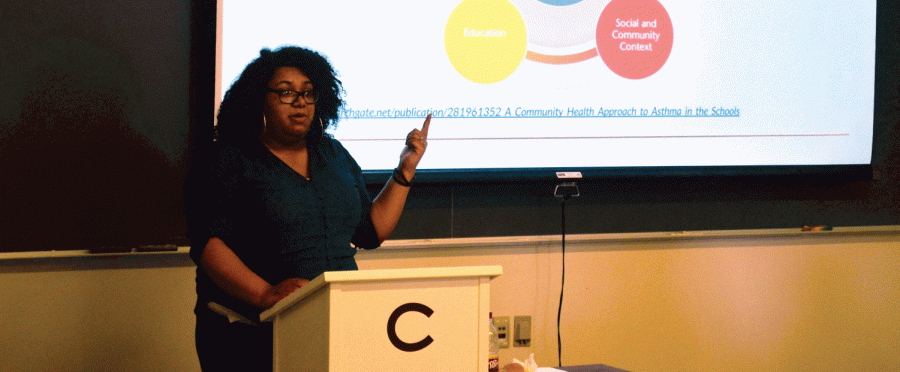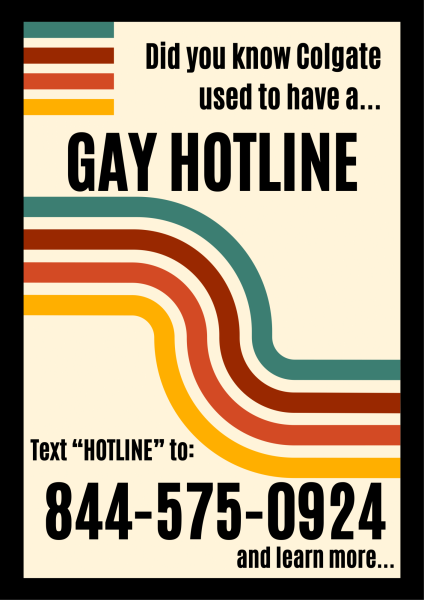Examining Sexual Violence Through a Public Health Lens
On Thursday April 4, Haven and Colgate’s Public Health Initiative hosted Tracia Banuelos, the Program Coordinator of Haven, for a talk on “Examining Sexual Violence Through a Public Health Lens.” The event was part of Colgate’s programming for Sexual Violence Awareness Month.
Banuelos opened the talk by defining the five social determinants of health: economic stability, neighborhood and built environment, health and health care, education and social and community context. These social determinants of health and the environment in which people are born, work and live affect their health and quality of life. Using these five determinants as “entry points,” Banuelos analyzed the healthiness of lifestyles to better understand sexual violence.
Baneulos defined sexual violence as “the broad term that encompasses any attempted or complete act of violence, either physical or psychological, carried out through sexual means or by targeting sexuality.”
Despite this definition, in the United States, each state has the power to define sexual violence. This results in 50 different definitions and 50 different approaches to sex education. Through a simple raise-your-hand exercise, only two students out of around 50 in attendance raised their hands when asked if they had learned about sexual violence in high school. When asked if they had been taught where to report acts of sexual violence or how to seek therapy in high school, only one student raised their hand. The lecture room was stunned by the lack of sex education across the board. This quick exercise made the problems with sex education readily apparent and showed that private schooling and wealth largely determine one’s access to a comprehensive sex education.
For example, the state of Kansas even turns down funds from the federal government for sex education, believing it to be detrimental to education and student lives. These factors, which individuals and young children have little to no control over, directly affect their lives and futures.
“Even if we’re talking about [sexual violence], it doesn’t mean that sexual violence is stopping,” Banuelos said. “We have to get to a point where we move from discussion to actual action so that we can end violence.”
The five determinants of health have the potential to move the conversation to action that will bear results. Banuelos stated that Ireland recently passed the decision to give paid time-off for sexual assault victims. This legislation provides victims with more economic stability so that they can go to the doctors and leave dangerous situations. Changing the U.S. education system would also positively impact society, as knowledge has life saving capabilities.
“All people deserve access to health,” Banuelos said.
However, withholding education and knowledge prevents individuals from truly leading a healthy life. Education also enables individuals to understand how to proceed after sexual violence in order to be both physically and psychologically healthy.
The public health model is another approach to ending sexual violence. By defining and monitoring the problem, the model identifies the risk and protective factors in order to strategically target norms. These factors don’t cause violence, however they increase the likelihood of a behavior and are useful to develop and test prevention strategies. Using evidence-based models to meet a community’s need and tools that are valid and reliable, sexual violence will hopefully come to an end. To have a widespread impact, these strategies need to have widespread adoption.
Haven has applied the public health model to the way they interact with the Colgate community. Rates of sexual violence are higher at Colgate than the national average. First and second-year students, LGBTQ students and alcohol/substance use are the main risk factors of this campus. The protective factors include fun, safe and dry spaces for students.
I’ve worked in public health before, but I’ve never seen the public health model used to explain sexual violence,” sophomore Alyssa Mast said. “I liked how they applied it to Colgate because a lot of people aren’t aware of it.”
Some of the tested prevention strategies used at Colgate include Yes Means Yes and the Haven Ambassador Project. Colgate hopes to help other universities implement similar types of programs.
“We don’t charge other institutions to use a curriculum. We promote what we’re doing and let other schools have access to the curriculum,” Banuelos said.
Students at the event found it to be both interesting and enlightening.
“I don’t think many people view sexual violence as a public health issue, but this presentation really brought to light that in reality it is,” first-year Jessica Livney said. “Sexual violence affects so many different populations, and viewing the issue from all these different contexts is so important to putting a stop to it. As a public health initiatives member, the presentation really inspired me to help combat sexual violence on campus.”
Contact Lilley Salmon at lsalmon@colgate.edu.










